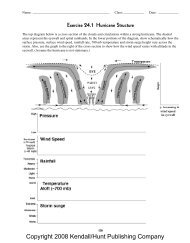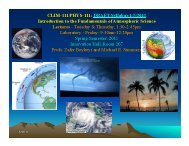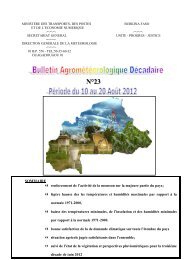Copyright 2008 Kendall/Hunt Publishing Company - CAMP
Copyright 2008 Kendall/Hunt Publishing Company - CAMP
Copyright 2008 Kendall/Hunt Publishing Company - CAMP
Create successful ePaper yourself
Turn your PDF publications into a flip-book with our unique Google optimized e-Paper software.
Name: _____________________________________________ Class: ____________ Date: ____________<br />
Exercise 12.1 Where Will Freezing Precipitation Occur?<br />
The maps below show analyses of sea level pressure and fronts for four weather systems over the central United<br />
States. Shaded areas denote cloud cover. The 0°C isotherm for the surface is also indicated on each map. Assume<br />
for this exercise that precipitation is falling everywhere that clouds are present. On each of the maps, outline the<br />
regions that are likely to be experiencing freezing rain or freezing drizzle.<br />
Briefly explain why you chose the areas you did.<br />
<strong>Copyright</strong> <strong>2008</strong> <strong>Kendall</strong>/<strong>Hunt</strong> <strong>Publishing</strong> <strong>Company</strong><br />
93
<strong>Copyright</strong> <strong>2008</strong> <strong>Kendall</strong>/<strong>Hunt</strong> <strong>Publishing</strong> <strong>Company</strong>
Name: _____________________________________________ Class: ____________ Date: ____________<br />
Exercise 12.2 Fronts, Soundings, and Precipitation Type<br />
Altitude (kilometers)<br />
T below freezing<br />
T above freezing<br />
0°C<br />
NORTH<br />
A B C D<br />
SOUTH<br />
1. On the cross section above, freezing rain formed via the melting process is most likely to occur at<br />
point ___________________________________________________________________________________________.<br />
2. Based on the cross section, snow is most likely to occur at point ___________________________________.<br />
3. Based on the cross section, rain is most likely to occur at point ____________________________________.<br />
4. Based on the cross section, sleet is most likely to occur at point ____________________________________.<br />
Soundings were launched at points corresponding to locations A, B, C, and D. The temperature profiles from the<br />
soundings, in no particular order, are shown on diagrams E, F, G, and H. Match the temperature profiles to cross<br />
section.<br />
below<br />
0°C<br />
above<br />
freezing freezing<br />
below<br />
0°C<br />
above<br />
freezing freezing<br />
below<br />
0°C<br />
above<br />
freezing freezing<br />
below<br />
0°C<br />
above<br />
freezing freezing<br />
5. Which sounding would have been launched in freezing rain that formed via the melting process? __________<br />
6. Which sounding would have been launched in rain? _____________________________________________<br />
7. Which sounding would have been launched in snow? ____________________________________________<br />
8. Which sounding would have been launched in sleet? _____________________________________________<br />
<strong>Copyright</strong> <strong>2008</strong> <strong>Kendall</strong>/<strong>Hunt</strong> <strong>Publishing</strong> <strong>Company</strong><br />
95
<strong>Copyright</strong> <strong>2008</strong> <strong>Kendall</strong>/<strong>Hunt</strong> <strong>Publishing</strong> <strong>Company</strong>
Name: _____________________________________________ Class: ____________ Date: ____________<br />
Exercise 12.3 How Much Ice?<br />
Assume that a medium-size tree in your backyard weighs about 1 ton. An early fall cyclone passes your area and<br />
produces a local ice storm. Your tree has not yet lost its leaves, and has a full canopy. The freezing rain impacting<br />
the tree fell at a light rate, so that about 25 percent of the rain froze directly on the tree, while the remainder<br />
dripped to the ground and ran off, since the temperature of the ground was just above freezing.<br />
Assume that your tree’s canopy is circular and has a radius of 5 meters. Also assume that 1 centimeter (0.01 meter,<br />
or 0.4 inches) of rain fell during the storm. What percentage of the tree’s original weight did the ice on the tree<br />
weigh at the end of the storm? Show how you arrived at your answer.<br />
Useful numbers:<br />
(ρ w ) Density of water = 1000 kilograms/cubic meter<br />
1 ton = 2000 lbs = 908 kilograms.<br />
<strong>Copyright</strong> <strong>2008</strong> <strong>Kendall</strong>/<strong>Hunt</strong> <strong>Publishing</strong> <strong>Company</strong><br />
97
<strong>Copyright</strong> <strong>2008</strong> <strong>Kendall</strong>/<strong>Hunt</strong> <strong>Publishing</strong> <strong>Company</strong>
Name: _____________________________________________ Class: ____________ Date: ____________<br />
Exercise 12.4 Freezing Drizzle Versus Freezing Rain<br />
Each statement describes a type of freezing precipitation (or both). Identify the type of precipitation by circling the<br />
appropriate abbreviation: ZR (freezing rain), ZL (freezing drizzle), or B (both freezing rain and freezing drizzle).<br />
1. ZR ZL B Leads to the development of an ice glaze.<br />
2. ZR ZL B Can occur in the atmosphere when the temperature of the air aloft is below freezing from the<br />
ground to the tropopause.<br />
3. ZR ZL B Typically is responsible for significant ice storms that produce millions of dollars in damage.<br />
4. ZR ZL B Can lead to traffic accidents.<br />
5. ZR ZL B Is the primary cause of aircraft icing.<br />
6. ZR ZL B Has the highest frequency of occurrence in the Northeastern United States and Canada.<br />
7. ZR ZL B Has the highest frequency of occurrence in central Canada.<br />
8. ZR ZL B Occurs when snow aloft falls into a warm layer where the air is above freezing, melts, and<br />
then supercools in a subfreezing layer of air near the surface.<br />
9. ZR ZL B Is composed of supercooled water.<br />
10. ZR ZL B Does not require a temperature inversion aloft.<br />
11. ZR ZL B Can freeze upon contact with cars, trees and road surfaces.<br />
12. ZR ZL B Accumulation may lead to power outages, disrupt air and ground transportation and cause<br />
considerable property damage.<br />
<strong>Copyright</strong> <strong>2008</strong> <strong>Kendall</strong>/<strong>Hunt</strong> <strong>Publishing</strong> <strong>Company</strong><br />
99
<strong>Copyright</strong> <strong>2008</strong> <strong>Kendall</strong>/<strong>Hunt</strong> <strong>Publishing</strong> <strong>Company</strong>







